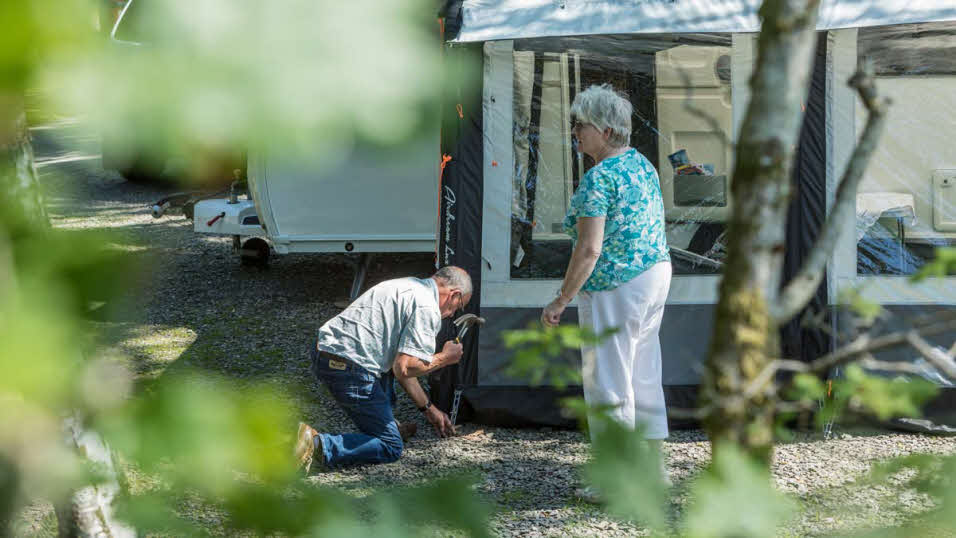Awnings
Before you choose which awning to buy, see which is best for you in our guide
Which awning is for you?
Once you've been through the process of choosing your awning, and hopefully armed with a little knowledge of the prodcut you've purchased, it's time to test it out. To help save you some time, we've put together this quick guide on how to put up a caravan awning.
Before putting up an awning
Each awning has its own way of going up so always read the user instructions carefully all the way through before erecting for the first time. Remember the first time will be the trickiest, so do not despair! Although it can be done single-handedly with a bit of practice, realistically it’s a two-person job – especially in high winds.
First thread the awning cord through the channel, starting at the end or one of the widened entry points. The easiest way is to have one person feed the awning cord in at the start point (usually the rear end of the caravan is best), and the other helps it along to the end (unless that person is tall a step will be needed). Never force the awning - lubricants are available to help thread through a particularly stubborn awning.
Once the awning is completely through and positioned centrally where you want, leave it hanging and sort out the poles. Place them in the appropriate position alongside the caravan and have a run through to ensure everything fits together. Leave the legs retracted to make life easier.
Start by creating the centre apex, attach the centre roof pole to the caravan, connect this to the centre leg pole and adjust the leg height to the desired height. Repeat this process under the canvas and finally tension the whole lot in small steps and evenly throughout.
If it is windy beware gusts that come up and under the awning roof – this is the most likely time the awning will blow over the top of the caravan. If very windy it is advisable to take the awning down altogether.
Add the guy ropes as soon as possible and tension as recommended. Peg out the mudwall/skirt starting nearest to the caravan and drive the pegs at an angle to get the best grip in the soil. Take the strain off zips by cross pegging at the base. Finally add the draught skirt, wheel arch cover (if separate) and curtains.
Reverse the process but remember that as soon as you slacken off some poles others will immediately decide to collapse so make sure someone grabs them before they damage the caravan sidewall or windows.
If the poles are damp, wipe them down before putting away and if the awning is wet, dry it out at the earliest opportunity. Never leave more than 24 hours in this condition. Even if the weather is still wet, it would be better to put the awning back up in the rain than leave it packed wet.
The golden rule is never to pack an awning away when wet or even slightly damp, or mildew will result. It should be stored in a dry, well-aired place; the caravan is fine in summer but too damp for the winter. An attic is ideal, or even a dry garage providing the awning is kept off the concrete floor and out of reach of vermin. Store poles and canvas separately and although you can wipe steel poles with a lightly oiled cloth to prevent corrosion, all traces of oil must be removed before the poles come into contact with the awning again.
Always wait until the canvas is dry before dealing with mud or dirt, when it can usually be removed with a stiff brush. Stubborn marks can be tackled with plain water, but anything stronger should be avoided if possible. If too unsightly, try soap and water but never detergent. Any area touched by the soap solution will have to be reproofed. Specialist cleaners are also available.
Your awning will need regular reproofing – ideally every season. Small patches can be treated with an aerosol proofer and should be applied when the awning is dry and in a well-ventilated place. For larger areas use a soft paint brush. Ideal conditions are a warm, dry day, but avoid hot sun which will dry the proofer out too quickly. Do not forget to protect vinyl windows, mudwalls, grass and tarmac while using products which contain spirit-based solvents. Do not pack the awning away until the solvent has completely dried out.
If you're new to caravanning then don't forget to check out our top 20 caravanning questions - an ideal starting point for beginners looking to learn more.